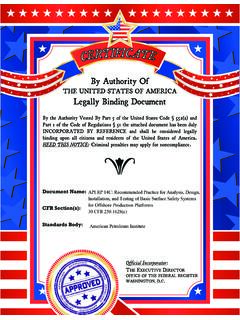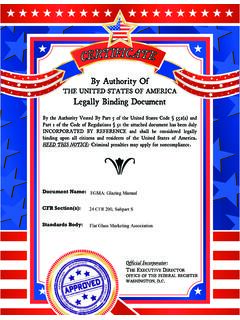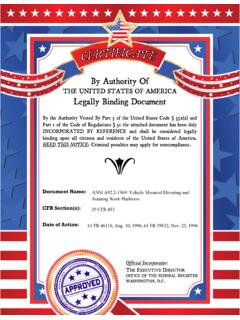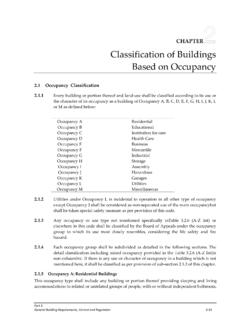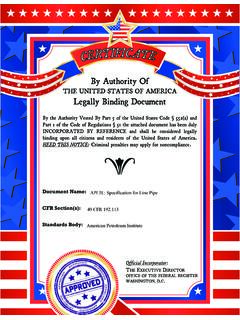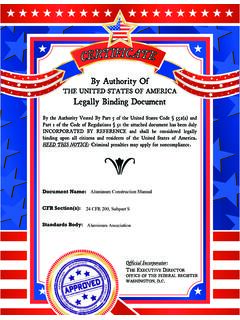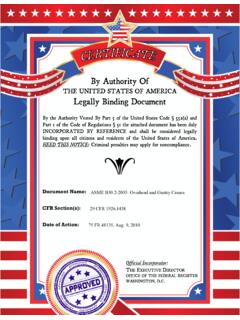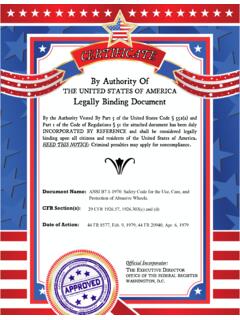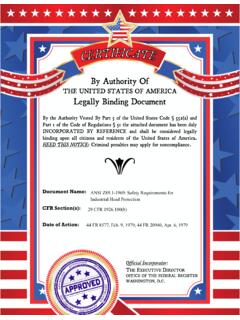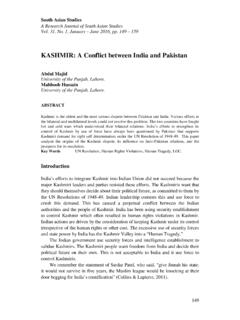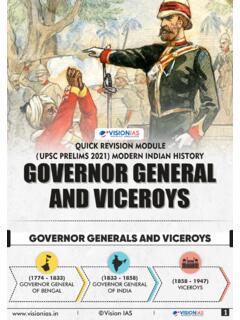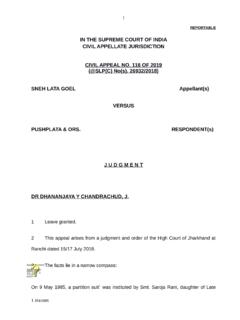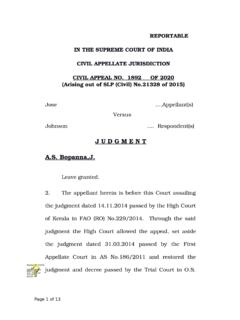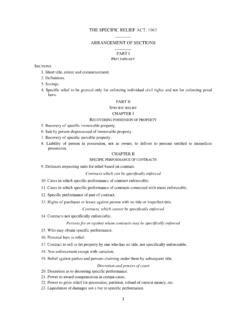Transcription of IS 2185-3 (1984): concrete masonry units, Part 3 ...
1 Disclosure to Promote the Right To InformationWhereas the Parliament of india has set out to provide a practical regime of right to information for citizens to secure access to information under the control of public authorities, in order to promote transparency and accountability in the working of every public authority, and whereas the attached publication of the Bureau of Indian Standards is of particular interest to the public, particularly disadvantaged communities and those engaged in the pursuit of education and knowledge, the attached public safety standard is made available to promote the timely dissemination of this information in an accurate manner to the public. ! $ ' + - Satyanarayan Gangaram Pitroda Invent a New india Using Knowledge 0 1 ' 5 Jawaharlal Nehru Step Out From the Old to the New 1 + , 1 + Mazdoor Kisan Shakti Sangathan The Right to Information, The Right to Live !
2 > 0 B Bhart hari N ti atakam Knowledge is such a treasure which cannot be stolen Invent a New india Using Knowledge IS 2185-3 (1984): concrete masonry units, Part 3:Autoclaved cellular Aerated concrete blocks [CED 53: CementMatrix Products]IS : 2185 ( Part 3 ) - 1984 (Superseding IS : 5482-1969) Indian Standard SPECIFICATION FOR concrete masonry UNITS PART 3 AUTOCLAVED CELLULAR (AERATED ) concrete BLOCKS ( First Revision ) First Reprint DECEMBER 1989 UDC :692, I . BUREAU OF INDIAN STANDARDS MANAK BHAVAN, 9 BAIIADUR SHAH ZAFAR MARC NEW DELHI llULO2 Gr 4 March 1985 Indian_ Standard SPECIFICATION FOR concrete masonry UNITS PART 3 AUTOCLAVE0 CELLULAR ( AERATED ) concrete BLOCKS ( First Revision ) Cement and concrete Sectional Committee, BDC 2 DRH. C. VISVEWARAYI WJ R6pwnting Cement Re8eaTch lmtitute of india , New D&i ADDITIONAL DIIL~JTOB, STAEDARDS Research, Designs C Standards Orga&aGon (B&S) DEPUTY Dmto~on, STANI>ABDS ( Ministry of Railways), Lucknow (B&S) (A&s-s) SHRI %lOSRJlEE L+rsen 6 T&ro Ltd, Bombay< SIM HARISJI N.
3 MALANI ( Al:ernute ) SHRI S. K. Barrs~~xx DR K. S. BUL National Test How, Calcutta Struc;tu~~etgineenng Research Centre (CSIR ), SURI V. K. Gn~ ~ ( Al&mate? SHRI CHARRABOUTI RordrN~in@~poolSbippingand Transport, SHRI N. Ss~v~cro~o ( Al&a& ) Ca~u Earour~~~~ ( BD ) Soar J. C. BMUE ( Alhrnaie ) Beas Designs Organization, Nangal Tonnship CHlEI ENomBB (Drnane) EJlSclUTEYl E~OIXXIC~ Central Public Works Department, New Delhi ( D~;~xuN~ ) III ( Altmwte ) cFm ix ( RnEABCH )- Irrigation Department, Government of Punjab, Chandigarh R&BCH Ormc~ ( IPRI ) ( A&mate ) Dx% s. K. ClsoFxU Cement Research Insdtute of india , New Delhi D~ ~~1ox(A&aaets) (CmtinudrpegrZ) lication is protected under the ISr2183(Part3)-1384 . bhbns w-h DIXLEOTOB A. P. Engineerh~ Rerearch Laboratories, Hyderabad DIBWTOR Central Soil & Materi& Research Station, New Delhi DEPUTY D~~EOTOB ( Altmaate ) DIBE~OE (C & MDD-I ) Central Water Commission, New Delhi. DEPUTY D~sra~ ( C & MDD-I ) ( dttnnorr ) SHBI T.)
4 A. E. D SA Sasr N. C. Dnoaa~ ( Alknurtr ) The concrete Associition of india , Bombay SHRI A. V. GOKAli SHBI s. s. bfIQLANI(~hSUt4) Cement Controlier ( Ministry of Industry) SERI A. K. GUPTA Hydgak$atisbestos Cement Product Ltd, SERI P. J, .JroUS The .&o&ted Cement Companies Ltd, Bombay Sam M. R. VINAYAKA ( Ahmate ) SHRI N. G. JOSHI Indian Hume Pipes Company Ltd, Bombay SHXI S. R. KULKABNI M. N. Dastur & Co. Pvt Ltd, Bombay SHBI s. K. LAHA SHRI B. T. UNWALLA (Altcmute) The Institution of Engineers ( Is&a ), Calcutta SH~I G. K. MAJUXDAR Hindustan Prefab Ltd, New Delhi SERI H. S. PASRIOHA (A&era&) SHRI K. K. NABXBIAR In Personal Capacity ( Ramaaalaya II FirJt SEBI Y. R. PHULL SHBI Y. R. PHULL ~~~alRo~&.&n ~;~~Adp,~) esearcb Institute (CSIR), New Delhi &RI hf. R. CEATTEBJZ33 ( &Cfa& I ) SHRI K. L. SErHI ( ~bYfiUtC 11) DR MO~IAN RAI Central Building Research Institute ( CSIR ), Rmrkee Ds S. S. RE~SI (Alternuts) SHRI A. V. RAMANA Dalmia Cement ( Bharat ) Ltd.
5 New Delhi DB K. C. NARAN~ ( Altemats) DR M. RAMAIAH Struc;;i,ngineering Research Centre, ( CSIR ), DK A. G. MADHAVA RAO ( Alters& ) Directorate General of Supplies and Disposals, New Delhi SHI:I G. RAYDAJ DR A. V. R. RAO SHRI J. SEN GUPTA ( &en& ) SHRI R. V. CEALA~ATHI R*o Smtr S. ROY ( Altanorr ) SERI T. N. S. RAO (~) SRRIA~JUX RIJHSINGIIAI?I SH~I C. S. SHABXA (Ahnate ) Srn~ H. S. SATYANARAYMA National Buildii Orga&ation, New Delhi Gedegid Survey of india , Calcutta Gammon india Ltd, Bombay Cement Corpora&n of india Ltd, New Delhi Engineer-in-Chief s Branch, Army Headquarters, New Delhi SEBI V. R. KOTNI~ (Aftemote ) _ Central Board of Irrigation and Power, New Delhi 1 ~ICRETARY SERI K. R. SAXlENA ( Ahnatd , lSr2185(Part3)-1984 Indian Standard SPiXIFICATION FOR concrete masonry UNITS PART 3 AUTOCLAVED CELLULAR (AERATED ) concrete BLOCKS ( First Revision) 0. FOREWORD This Indian Standard ( Part 3 ) ( First Revision ) was adopted by the Indian Standards Institution on 30 April 1984, after the draft finalized by the Cement and concrete Sectional Committee had been approved by the Civil Engineering Division Council.)
6 A series of National Standards on the cellular concrete has been formulated so as to provide standard products for the construction of buildings. Cellular concrete is a class of material which has been developed commercially abroad and is coming in vogue in this country also. This specification is intended for cellular ( aerated ) concrete blocks and its manufacture using the method of generation of gas by chemical action, the details of which are broadly indicated in Appendix A. The Sectional Committee responsible--for the preparation of this standard has, however, no intention to freeze the method of manufacture to any one particular method. concrete masonry , already extensively U+ in building construction abroad, is likely to make very consider&e- headway in this country because of the many advantages, such as durability, strength and structural stability, fire resistance, insulation, and sound absorption it possesses.
7 concrete masonry construction is also economical because of the following aspects: 4 W The units are relatively largeadd true in size and shape. This ensures rapid qonstruction so that more wall is laid-per man-hour than in other types of wall construction; Fmm jointr result in considerable saving in mortar as compared to normal masonry construction, and also in increasing the strength of the wall, and 3 . +. r ;_ + IS:.2lSS(Part3)-1984 c) The true plane surfaces obtained obviate necessity of plaster for unimportant buildings situated in low rainfall areas; even when plaster is used br any reason, the quantity required for satisfactory coverage is significantly small. concrete masonry has an attractive appearance and is readily adaptable to any rtyle of architecture. It lends itself bo a wide variety of surface fmishes for both exterior and Werior walls. It may also be finished with cement plaster, gauged with ltie or a plasticizer.
8 concrete masonry units provide a strong mechanical key, uniting the concrete masonry backing and the plaster finish in a strong permanent bond. , Autoclaved cellular ( aerated ) concrete blocks are ,used for both load bearing and. non-load bearing internal walls, partition and panel walls, inner leaf of cavity walls or as backing to brick masonry and for external load-bearing walls aa wd! as panel walls in steel or reinforced concrete frame construction when protected From weather by rendering or by some other efficient treatment. This standard was first published in 1969 as IS : 5482-1969 Specification for autoclaved cellular concrete blocks . This first +sion is being issued as IS : 2185 ( Part 3 > 19W under the modified title concrete masotiry units: Part 3 Autoclaved cellular ( aerated ) concrete blo&ks and supersedes the former standard IS : W-1969..Part 1 of this standard Covers hollow as& solid concrete blocks of normal weight and Part 2 Covers hollow and solid light weight concrete blocks.)
9 Thii &cation in title is inte&ed far frcilitating the co-ordination of requirements of various types of concrete masonry units, covered under various Indian Standards. This standard incorporates significant modscations specially with regard to materials and physical requirements such as dimensions, surf&e finish and texture. Requirement of fire resistance has heen omitted from this revision and thermal conductivity has been retained. A clause on terminology has been added in this revision. For the purpose of deciding whether a particular requirement of this standard is complied with, the 6nal valw, ohserved or calculated, expressing the result of a test or analysis, shall he rounded off in accordance with IS : 2-196W. The number of sign&ant places retained in the rounded off value should he the same as that of the specified value in this standard. rRulea for rowding off numerical values (Ad). i$ 4 1. SCOPE This standard (Part 3 ) covers the requirements of autoclaved cellular - ( aerated ) concrete blocks &ving density up to 1000 kg, ms.
10 2 TERMXNOLOGY 20 For the purpose of this standard, the following definitions shall OpPlY. 21 AutocIivctt -Steam curing of concrete Products, sandlime bricks, asbestos cement products, hydrous calcium silicate insulation Products, or cement in an autoclave at maximum ambient temperatures generally between 170 and 215oC. 22 Block - A concrete masonry unit, any one of the external dimensions of which is greater than the corresponding dimension of a brick as specified in IS : 33520197W, ,and of such sixe and mass as to P&nit it to be handled by one man. Furthermore, to .avoid czfusion with slabs and Panels, the height of the block shall not exceed either its length or six times its width. Block Density - The adensity calculated by dividing the mass of a block by the overall volume, including holes or cavities and end recesses..24 Drying Sbriulmge - The difference between the length of specimen i which has been immersed in water and then subsequently dried to constant length, all under +.
